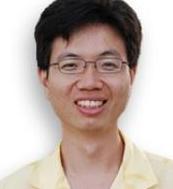UMass Amherst scientists advance knowledge of neurodegenerative fibril formation using computers at the MGHPCC.
Read this story at UMass News
AMHERST, Mass. - As physicians and families know too well, though Alzheimer's disease has been intensely studied for decades, too much is still not known about molecular processes in the brain that cause it. Now researchers at the University of Massachusetts Amherst say new insights from analytic theory and molecular simulation techniques offer a better understanding of amyloid fibril growth and brain pathology.

Jianhan Chen - Image credit: UMass Amherst.
As senior author Jianhan Chen notes, the "amyloid hypothesis" was promising - amyloid protein fibrils are a central feature in Alzheimer's, Parkinson's disease and other neurodegenerative diseases. "But the process is really difficult to study," he says. "For many years people thought the fibril might the harmful factor in the brain. But after billions of dollars of investment failed to deliver an Alzheimer's drug, that thinking is really questioned. We now believe that the fibril is not the toxic species, but it's the earlier forms, soluble oligomers or proto-fibrils. That's what we wanted to study."
Chen and first author Zhiguang Jia, a research scientist in Chen's computational biophysics lab, explored how building-block peptides form fibrils. "We are really proud of this work because, to the best of our knowledge, for the first time we have described the comprehensive process of how fibril growth can happen. We illustrate that the effects of disease-causing mutations often arise from the cumulative effects of many small perturbations. A comprehensive description is absolutely critical to generate reliable and testable hypothesis," he adds. Details of their multi-scale approach with many atomistic simulations are in Proceedings of the National Academy of Sciences.
Chen adds, "The process is slow and very complex. All the nonproductive pathways are usually hidden and have never been described in a comprehensive and quantitative fashion. It is like the dark side of the moon."
Chen says their model is "parameter-free and purely based on physics, with no fitting or assumptions needed. We provide a complete description of the process and the physics just comes out naturally. It's really satisfying; we feel it's a real breakthrough."
He and Jia focused first on how peptides in disordered solution behave. The process starts with peptides in a partially unfolded conformation, Chen notes. They describe both productive and non-productive aggregation processes and point out that non-productive ones can take a very long time to disengage from interactions. "It's like hiking in the woods without a path," Chen says. "It's like a maze. And if one peptide takes a mistaken pathway, it has start over and retry many, many times."
A key insight was to account for these many non-productive pathways - too many possibilities - that slow movement and cause a "kinetic bottleneck," he says. Another important insight, Chen points out, is that the "energy landscape" as biophysicists call it, is crucial. With "usual" structured proteins, in spite of their great complexity, they fold quickly because the underlying energy landscape is well structured to support quick, efficient folding.
By contrast, fibril growth occurs in a "really flat" energy landscape, he adds. "There are many, many mistakes before you fall into the hole that will lead to fibril formation." Biochemists call it "unguided search," he says, adding that "bumbling" is a good way to describe it.
Modeling and characterizing such unguided systems are extremely difficult, the biophysicist notes. "To use a simulation to predict the process, you need a complete description of the whole maze or you can never grasp it, and this is almost impossible. To describe comprehensively the search space, you must compromise resolution of peptide modeling. When you limit the resolution of the model, you'll not be able to faithfully capture the impacts of disease mutations, for example."
He says these conflicting requirements - resolution and completeness - must be satisfied at the same time. "Our approach is the first to satisfy both. This is one of our technical breakthroughs," Chen says.
Chen says a key inspiration for the multi-scale algorithm came from theoretical work from Jeremy Schmit, a collaborator and co-author of the paper from Kansas State University. "Together, we show how to achieve a description of the peptide search process at the atomic level. We demonstrate our approach by looking at how mutations in amyloid beta peptide affect fibril growth. Our results show that we can reproduce what is known about these mutants, plus peculiar non-additivity of mutations, that is observed experimentally. It means that two positions can mutate and either one will make fibril growth go faster, but if both are mutated, fibril growth goes slowly."
###
Chen and Jia's code is publicly available and the framework has been demonstrated, so it could be used by others to look at other fibril-forming peptides, they say. This work was supported by the U.S. National Institutes of Health, with computing performed on the Beocat Research Cluster at Kansas State University and the Pikes cluster housed in the Massachusetts Green High-Performance Computing Center.
Publication
Zhiguang Jia, Jeremy D. Schmit, and Jianhan Chen (2020), Amyloid assembly is dominated by misregistered kinetic traps on an unbiased energy landscape, PNAS, doi: 10.1073/pnas.1911153117
